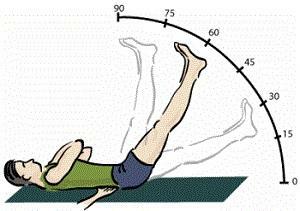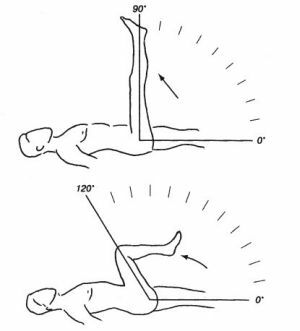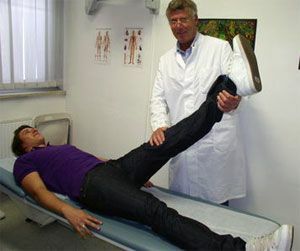 Sometimes it's very difficult to diagnose a neurological disease correctly. This is due to the fact that most patients are not able to objectively assess the pain, and exaggerate the scale of the symptoms.
Sometimes it's very difficult to diagnose a neurological disease correctly. This is due to the fact that most patients are not able to objectively assess the pain, and exaggerate the scale of the symptoms.
With prolonged soreness, a situation may occur in which a person is unable to correctly interpret pain, and in rare cases, it may be completely ignored. You can identify an objective picture of neurological diseases of the spine with the help of tension symptoms.
Symptoms of tension
Symptoms of tension are signs of neurological diseases of the spine, which are accompanied by muscle spasms or other causes that cause difficulties in the movement and stretching of the nerve roots. The symptom of tension can indicate degenerative changes in the spine and osteochondrosis. The provocation of passive movements causes severe pain.
In neurology, 7 tension symptoms are distinguished: 
- Dejerine;
- tripod;
- landing;
- of Wasserman-Matskevich;
- Bonner;
- Neri;
- Lasega.
Lasega test
For the first time the symptom was discovered by the French neurologist Laceg in the middle of the 19th century. He conducted an experiment in which he discovered a sharp pain in the patient when he lifted an even foot in a reclining position, after flexing the knee or hip joint, painful sensations cease immediately.
Tenderness when raising the lower limb in the forward position occurs due to the stretching of the sciatic nerve, while the pain reaction can cause the stress of only one nerve root. The pain reaction arises because the roots of the nerve in the intervertebral foramen are squashed when exposed to excessive tension.
Normally, stretching the nerve within the physiological process can not cause its overstrain, and movement in the intervertebral foramen is smooth, the spine easily slides on it without excessive compression. Painful sensations can arise because the nerve fibers of the sciatic nerve can not elongate naturally, this may be due to its pinching or overexertion.
The sciatic nerve is the largest nerve in the human body and positive Lasega syndrome can indicate a number of diseases throughout its extent. Doctors use the symptom of tension to make an accurate diagnosis of diseases of the lumbosacral spine.
How the
test is performed The Lasega symptom test can only be performed by a neurologist. Indications for the study may be the patient's complaints about discomfort in the lumbar region, gluteus muscles, hip and thigh muscles during movement.
 Discomfort may manifest as limited movement, the appearance of pain or numbness in the area of passage of the sciatic nerve. Perhaps the manifestation of pain on only one side, this indicates a one-sided defeat.
Discomfort may manifest as limited movement, the appearance of pain or numbness in the area of passage of the sciatic nerve. Perhaps the manifestation of pain on only one side, this indicates a one-sided defeat.
For the procedure, the patient is placed on his back on a firm, stable surface. In the lying position, the patient does not experience unpleasant sensations, the nerve roots are completely relaxed and do not cause pain.
The specialist slowly flexes the limb in the hip joint, with the patient's knee bent. In this position, the nerve and its roots are still relaxed, and movement does not cause discomfort. Further the doctor smoothly raises a leg, thus the finiteness should be equal.
The Lacega strain symptom is considered negative if the subject does not experience pain when lifting an even limb. Positive can be considered a symptom in the case when the subject feels pain when raising his leg, after it is bent at the knee joint, the pain abruptly disappears.
False positive symptom is most often observed in the elderly, it speaks of a weak tonus of the musculature, and is not associated with the overgrowth of the sciatic nerve.
Highlights of the study:
- The extremity should rise very smoothly, it is forbidden to bend the leg sharply, this can cause serious damage to the sciatic nerve.
- The study should be discontinued immediately after the onset of the pain symptom.
- The procedure can not be administered to patients who are anesthetized or anesthetized. The result of such a study can not be reliable, and the absence of a pain protective mechanism can cause a rupture of nerve fibers.
- When receiving a positive test for Lacega's symptom, the patient should be referred for additional examination of the lumbosacral spine.
Causes of the syndrome
The main reason for the positive result in the Lasega symptom test is the intervertebral hernia. The mechanism of the appearance of the symptom is due to the fact that the tissues supporting the intervertebral disc in their physiological position are damaged, stretched and the disc can be displaced towards the spinal canal.
In the canal, the disc can exert pressure on the roots of the sciatic nerve; in the relaxed state, the patient does not experience pain, but under tension, the nerve must round the body of the intervertebral disc, which causes it to stretch over a large length, but it is not capable of it. Thus the painful sensations arise in the field of a loin. The detection of such a symptom requires an additional X-ray examination to clarify the diagnosis.
The appearance of soreness while performing the test in the area of the gluteal muscles may indicate the osteochondrosis of the lumbosacral section.
Diseases accompanied by Lasega's symptom:
- osteochondrosis;

- neoplasm in the region of passage of the sciatic nerve;
- occurrence of intervertebral hernia and disc displacement;
- sciatica nerve injury;
- compression of the nerve root with muscles around the buttocks;
- compression of the distal vertebral column;
- accumulation of mineral salts in the ligaments in the region of the spine.
Evaluation of the results
The appearance of soreness with a 60-degree elevation of the leg can not indicate a positive Laseg symptom, this is due to the fact that at this angle the nerve reaches its maximum extension.
Flexion of the limb at an angle of 40-60 degrees also causes maximum stretching of the nerve, pain can not be associated with the symptom of tension, but speak of the maximum length of the nerve.
Only bending the leg at an angle of up to 30 degrees indicates the true symptom of Lasega.
The manifestation of Lasega's syndrome may indicate the development of certain diseases of the lower spine, but is not a prerequisite for establishing a definitive diagnosis. To accurately determine the disease, methods are used to identify other symptoms of tension, fluoroscopy and MRI.



